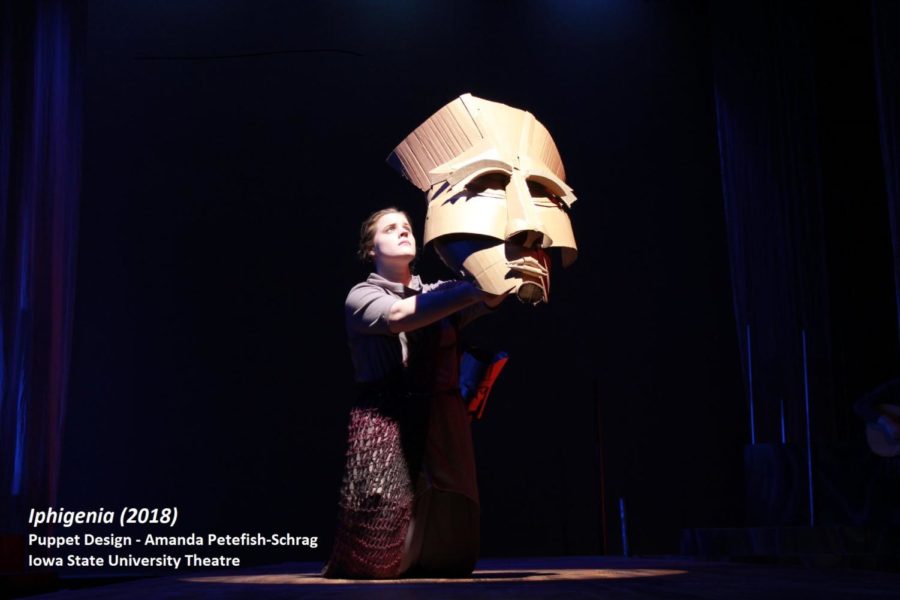- Ames247
- Ames247 / Music
- Ames247 / Music / Campus
- Limelight
- Limelight / Culture
- Limelight / Culture / Campus Culture
- Limelight / Music
Jazz and Puppetry Work in Tandem in “Rhapsody in Plastic”
April 17, 2018
A show on Thursday, April 19 will combine puppetry and jazz music for a unique storytelling performance. The show, which is titled “Rhapsody in Plastic,” will take place in the Martha-Ellen Tye Recital Hall at 7:30 p.m. It is free and open to the public.
“Rhapsody in Plastic” will be a collaborative effort from the ISU Jazz Ensemble with members of the theater department. The show will consist of four short-form stories, each told through jazz music and puppets.
Michael Giles, director of the ISU Jazz Ensemble, composed each musical number to be performed. Amanda Petefish-Schrag, assistant professor of theater, personally designed the puppets that will be used throughout the performances.
Petefish-Schrag was initially approached by Giles to put together this show. She was compelled to join because of her interest in the ways that different mediums can be combined for storytelling purposes. “This isn’t something we have done at ISU before,” said Petefish-Schrag. “This is very much an experiment.”
For each of the four stories performed, the ISU Jazz Ensemble will be on stage while the puppeteers perform front and center.
“We’re really trying to marry the two things together, so [we will show] how these puppets really reflect that jazz feel,” said Petefish-Schrag.
Petefish-Schrag said neither the jazz nor the puppet elements are supposed to have more importance over one another. They are intended to work in tandem.
“Hopefully because of the jazz music, you experience the puppet work differently, and because of the puppet work, you experience the jazz differently as well,” said Petefish-Schrag.
In each story, the puppets’ actions will generally reflect the jazz music being played, but according to Petefish-Schrag, there will be moments throughout the performance when the jazz musicians make alterations to the music based on the movements of the puppets. She metaphorically described the structure of the performances as a conversation, as opposed to a pre-planned speech. “We know what the topic is, and we know the key points that we’re going to hit. But there is also this element that we’re responding to what’s happening in the room at the moment,” said Petefish-Schrag.
Though each of the short performances will tell a different story, they are all loosely connected by a theme. Petefish-Schrag said that ideas of discovery, renewal and seeking things anew are themes that link the stories together.
“A lot of the stories we are trying to tell are about characters who are discovering things for the first time or starting to look at another character in a different way or discovering new things about themselves,” said Petefish-Schrag.
Examples of the different puppet characters will be animals, humans, butterflies, dogs and birds. Petefish-Schrag said a lot of these characters will look colorful and act playful. She said she drew inspiration from Giles’ compositions when designing the puppets.
“There’s this inherent sense of playfulness in the work that [the ISU Jazz Ensemble] is doing that I think is really helpful in helping us as puppeteers really find the sense of play in what we’re doing,” said Petefish-Schrag.
The show’s overall title, “Rhapsody in Plastic,” is a play on George Gershwin’s jazz classic “Rhapsody in Blue.” The title also stems from the fact that all the puppets are designed using recycled plastic. For example, she used discarded food packages to design the colors of the puppets. She also used old plastic conveyor belt scrubbers for some of the structural components of the puppets. Using these types of materials was an artistic choice on her part.
“I think that puppetry, like any good art, is trying to reframe the way we look at the world. And in this case, maybe reframe the way we look at what we throw away,” said Petefish-Schrag.
She tried to stay away from making her puppets look too realistic. Instead, she wanted to only include what is essential to the character. For example, she tried to keep the essential characteristics of a child’s movement, or the essential characteristics of a dog’s appearance.
“Puppetry is really equal parts engineering and aesthetics. I can create a puppet that is really beautiful, but if it doesn’t move the way I need it to move, or if it is too heavy, it can’t tell the story it needs to tell. And vice versa, I can create a puppet that moves really well, but if there’s nothing about it that draws the audience’s eye in, then it’s ineffective. It’s part of what makes puppetry challenging but part of what makes it an exciting medium,” said Petefish-Schrag.







